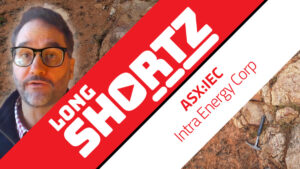With Starpharma (ASX:SPL) shares having lost losing three-quarters of their value over the previous year when new CEO Cheryl Maley reported for duty on January 8 this year, the former big drug company exec knew that maintaining the status quo wouldn’t cut it.
With the freedom to make changes enjoyed by an incoming chief, Ms Maley initiated a business review involving management, the board, external experts and some shareholders.
Unveiled in May, the soul-searching effort concluded that the dendrimer technology specialist (see below) was confusing investors with its array of early to late-stage programs, notably in cancer.
“Over the years, the broad portfolio from early assets to commercial assets … has been a strength for Starpharma,” Ms Maley says.
“But we have learned that having those broad options perhaps has led to a loss of identity, or some confusion about what is Starpharma’s core value proposition.”
That said, the new guard is not exactly chucking out the baby with the bath-water, with the clinical cancer programs reduced from three to two (again, see below).
The company is also honing its approach to partnerships, one example being an equity involvement in a drug development joint venture with the London-based life sciences investor Medicxi Ventures.
And, yes, investors can also expect a nip and tuck of the cost base.
Star(pharma) gazing over time
Starpharma listed in September 2000 as a Paul Keating-era pooled development fund (PDF). Despite these PDFs being valuable – they confer tax advantages at revenue stage – the company shed the structure.
Starpharma sold its agricultural chemical division to Canadian agri-giant Agrium in 2017 for $35 million, in favour of focusing on two-legged beings.
Starpharma used to sell Vivagel-coated condoms to the ASX-listed Ansell, before Ansell sold its ‘sexual health’ arm to Chinese interests in 2016. But Starpharma still has, er, things covered with Japan’s Okamoto Industries.
Formerly a practising veterinarian, Dr Jackie Fairley became CEO in July 2006 and held the role for an almost record-breaking 17 years.
Holding a science degree majoring in human physiology, Ms Maley started out in a research role at CSIRO and then had 25 years in the pharmaceutical sector, including at Novartis, Abbvie/Abbott, Servier Laboratories and Wyeth Pharmaceuticals.
At Novartis she was Australia and New Zealand head of oncology.
“I have launched many products in different regions and countries and I can bring that experience to Starpharma,” she says.
Dendrimer focus
Starpharma’s reason for being is its dendrimer enhanced product (DEP) platform, with the company laying claim to being the only one to commercialise a DEP product (the bacterial vaginosis treatment Vivagel).
Before you ask, dendrimers are nanoscale polymers aimed at improving drug efficacy and reducing side effects (such as bone marrow toxicity and hair loss).
The company broadened to a series of oncology programs that combine the dendrimer with three existing drugs.
They are irinotecan (colorectal cancer), cabazitaxel (prostate cancer and others) and docetaxel (breast, head and gastric cancers).
While all programs have completed phase II trials, work on the last has been paused.
“It would be fantastic to progress all of the assets … but we need to prioritise to allow us to be successful in a partnering and licensing deal,” Ms Maley says.
The cabazitaxel program adds DEP to Jevtana, a Sanofi-Aventis drug.
The irinotecan program tricks up Pfizer’s drug Camptosar. A phase II program showed efficacy in multiple tumor types including colorectal, breast, ovarian, pancreatic, lung and oesophageal.
Medicxi deal heralds corporate renaissance
As with E-harmony, Starpharma is all about partnering.
In April, the company said it would co-found a UK-based company, Petalion Therapeutics with Medicxi Ventures.
The venture will develop one of Starpharma’s molecules for an unnamed dendrimer drug conjugate target. Medicxi will chip in up to $US25 million (AUD $38 million) and Starpharma will contribute “certain intellectual property” for a 22.5 percent Petalion stake.
The Medicxi moolah will be trickled out via a “tranched investment plan with defined scientific and technical milestones”.
Starpharma will provide research and development services on a fee-for-service basis and continue to own the background intellectual property.
“We had looked at a specific target, which gives us a specific asset,” says Medicxi principal Shyam Masrani.
“We went around the world to find the right platform and that brought us to Melbourne and Starpharma. We are standing on the shoulders of giants.”
The former global head of medicine at Boehringer Ingelheim, Petalion CEO Dr Mehdi Shahidi says Medicxi focuses on specific drug targets and indications.
“We focus on what patients we are developing it for – and why it is better.”
The Starpharma deal is Medicxi’s second Australian technology foray, having invested in a Pfizer vaccine developed by the University of Queensland.
Dr Shahidi says it’s hoped that the project can get to proof-of-concept stage within two to four years, with “real value” emerging in three to four years when the clinical efficacy is proven.
Keep up!
Meanwhile, Starpharma has research partnerships with Genentech and Merck Inc (Merck Sharp and Dohme outside the US) and a quiescent one with Astrazeneca.
Ms Maley says management has been reminded – possibly rudely – that the Starpharma programs are only “one of many” for the big pharma partners.
“We will attempt to be agile but the partners … may not be moving as quickly as we can,” she says.
In the meantime, she says, the dendrimer technology – now in its fifth generation – has moved ahead.
“It has become a flexible, precise and scalable opportunity for us and for partners,” she says.
Fuelling the funnel
Ms Maley says the company has done well with early research and experimentation and is keen to feed the “funnel” of new projects, which could be off the company’s own bat, through partnerships or other forms of non-dilutive funding.
“Across any drug development … there are losses and failures along the way,” she says.
“Our aim is to increase our shots at goal and advance them where we could add significant value.”
Ms Maley calls out the company’s special interest in improving the efficacy of both radio-diagnosis and radio-therapy.
“Dendrimers allow a treatment that is fast-in to tumour and fast-out of blood, reducing exposure to non-target tissues such kidneys and increasing accumulation in the target tumour,” Ms Maley says.
The company aims to be in phase I next year.
Another area of interest is the HER2 target, a validated marker in many forms of cancer including breast.
Ms Maley says a number of HER2 treatments are emerging, but many have toxicity issues.
“This increases the importance of accurate diagnostics to ensure the right patient gets the right treatment at the right time.”
Vivagel
Vivagel is an alternative to the out-of-favour, prescription-only treatments for bacterial vaginosis (BV). The company claims the over-the-counter product both treats and prevents the odiferous bacterial condition.
Sold under the Fleurstat brand, Vivagel was launched in the local market in April 2019 and roll-outs in Europe and Britain ensued. The product is approved and licensed in 160 countries.
In Europe, Vivagel was distributed by Mundipharma under the moniker Betadine BV, but the tie-up was dissolved last year and Starpharma is scouring for a new partner.
A notable exception to Vivagel’s global reach is the US, with the US Food & Drug Administration (FDA) unconvinced about the product’s benefit for the nation’s 125 million women.
The company has signed Itrom Pharmaceutical Group to distribute in the Middle East, also a former Mundipharma geography.
A variant of Vivagel, Viraleze is an anti-nasal nasal spray sold in 35 countries, but mainly online.
Finances and performance
In the March 2024 quarter, Starpharma recorded revenue of $371,000 and net outgoings of $5.32 million.
At quarter’s end Starpharma held cash of $26.6 million and the company expects a $5 Million Federal Research and Development Tax Incentive in September 2024.
In the December half year, the company reported adjusted revenue of $1.47 million, derived from product sales, royalty and licensing payments and research revenue from commercial partners and $828,000 of interest income.
The company’s ‘official’ half-year revenue was $8,025,000, including a $6.55 million payment from Mundipharma as a termination settlement.
Starpharma reported a loss of $1,034,000, but excluding the Mundipharma settlement the deficit was $7,587,000.
Ms Maley says with the phase II trials wrapping up, the company’s research and development expenses – $3.3 million in the March quarter – are abating.
Expense wise, management has identified $2 million of savings in fixed costs for the 2024-’25 year.
Over the past 12 months. Starpharma shares have gyrated between 50 cents in mid-September last year and the current sub-10 cents lows.
The share slump resulted in Starpharma being chucked out of the S&P ASX All-Ordinaries index on March 18 this year.
The five-year chart shows a high of $2.36 in February 2021. According to Commsec data, the current nine cents price is the lowest in Starpharma’s 24-year history.
Starpharma at a glance
ASX code: SPL
Share price: 9.9 cents
Shares on issue: 412,372,598
Market cap: $40.8 million
Chief executive officer: Cheryl Maley
Board: Rob Thomas (chair), Ms Maley, David McIntyre, Lynda Cheng, Dr Jeff Davies, Dr Russell Basser
Financials (March quarter 2024): receipts $371,000, net cash outflows $5.327 million, cash balance $26.5 million, quarters of available funding 5.1 (with access to undrawn loan facilities of $591,000
(December half 2023): revenue $8.025 million (up 400%), adjusted revenue $1.472 million (down 8%), loss of $1.034 million (previous loss $8.277 million), adjusted loss $7.587 million (the adjusted figures exclude the impact of $6.55 million received in August 2023, as settlement of an agreement with Mundipharma)
Major shareholders: Allianz SE 11.8%, Allan Gray 7.91%, UIL Ltd 6.69%, FIL Ltd (Fidelity) 5.2%, ICM Investment Management 5.2%
Dr Boreham’s diagnosis
Ms Maley notes the Starpharma register has tilted toward retail shareholders, which means the company will have to “change the way in which we communicate and engage”.
Indeed! Since the May 22 strategy manifesto, Starpharma shares have fallen a further 23 per cent and the company has an enterprise value (market cap less cash) of a mere $12 million.
Ms Maley acknowledges that investors are awaiting tangible results from the tighter focus.
“There is a strong belief in the value of the dendrimer technology, but there is also an increasing urgency to see a return on that value,” she says.
“But we have significant work to do to make sure that value proposition is recognised by the market and for our shareholders.”
Having been around for two decades, Starpharma shows that drug development is a tortuously long process.
It doesn’t help that sales of Vivagel – once the company’s prime focus – have underwhelmed.
Success with the Medicxi partnership will help to show whether Starpharma has entered a true renaissance, or is in danger of returning to the dark ages of large expenditures for little progress.
Disclosure: Dr Boreham is not a qualified medical practitioner and does not possess a doctorate of any sort. Like the Medici family he likes to think of himself as a cultured fellow but without the tendency to murder, conspire and corrupt.
This column first appeared in Biotech Daily
The post Dr Boreham’s Crucible: Is this dendrimer believer on the verge of a corporate renaissance? appeared first on Stockhead.






















